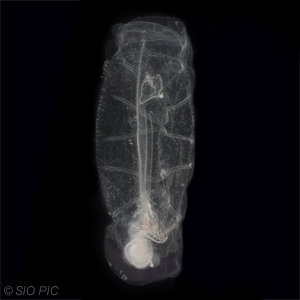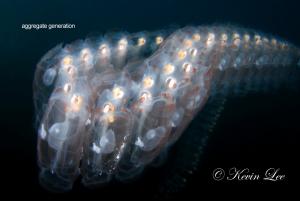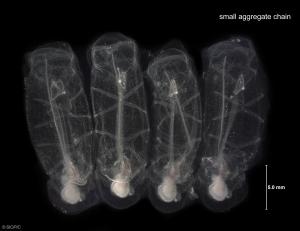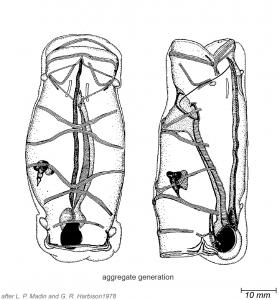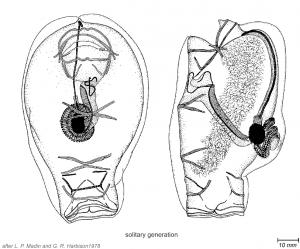Pegea socia
Both the solitary and aggregate generation have a thick tunic without pronounced thickening around the gut. In the aggregate generation, body muscle bands 1-2 and 3-4 barely touch and are not fused dorsally. Body muscle bands 1-2 are dorsally fused and 3-4 are touching but not fused in the solitary generation.
Pegea socia can often be mistaken for a similar species named P. confoederata. In the P. confoederata aggregate generation, the body muscle bands 3-4 meet and are fused. The video included for this species is said to be this closely related species, P. confoederata; however, the aggregate chain formation in P. socia is very similar.
video source: http://www.youtube.com/watch?v=8ccMPnY0GQg
Bone, Q., (1998) The Biology of Pelagic Tunicates, Oxford University Press, Oxford.
Madin, L.P., and Harbison, G.R. (1978) Salps of the genus Pegea Savigny 1816 (Tunicata: Thaliacea). Bulletin of Marine Science 28(2): 335-344.
van Soest, R.W.M., (1974) A revision of the genera Salpa Forskal, 1775, Pegea Savigny, 1816, and Ritteriella Metcalf, 1919 (Tunicata, Thaliacea). Beaufortia 22: 153-191.
Wrobel, D., and Mills, C. (1998) Pacific Coast Pelagic Invertebrates: A Guide to the Common Gelatinous Animals. Sea Challengers, Monterey Bay Aquarium, Monterey, CA.
Yount, J.L. (1954) The taxonomy of the Salpidae (Tunicata) of the Central Pacific Ocean. Pacific Science 8: 276-330.

